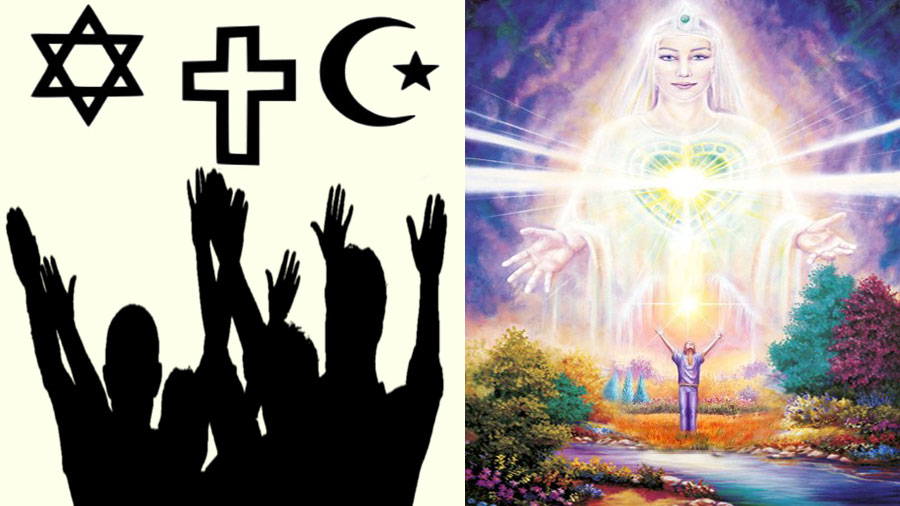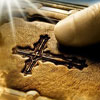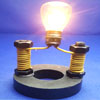Religion Versus A New Spirituality
 by Eckhart Tolle
by Eckhart Tolle
What is the role of the established religions in the arising of a new consciousness? Many people are already aware of the difference between spirituality and religion. They realize that having a belief system–a set of thoughts that you regard as the absolute truth–does not make you spiritual no matter what the nature of those beliefs is. In fact, the more you make your thoughts (beliefs) into your identity, the more cut off you are from the spiritual dimension within your self. Many “religious” people are stuck at that level. They equate truth with thought, and as they are completely identified with thought (their mind), they claim to be in sole possession of the truth in an unconscious attempt to protect their identity. They don’t realize the limitations of thought. Unless you believe (think) exactly as they do, you are wrong in their eyes, and in the not-too-distant past, they would have felt justified in killing you for that. And some still do, even now.
The new spirituality, the transformation of consciousness, is arising to a large extent outside of the structures of the existing institutionalized religions. There were always pockets of spirituality even in mind-dominated religions, although the institutionalized hierarchies felt threatened by them and often tried to suppress them. A large-scale opening of spirituality outside of the religious structures is an entirely new development. In the past, this would have been inconceivable, especially in the West, the most mind-dominated of all cultures, where the Christian church had a virtual franchise on spirituality. You couldn’t just stand up and give a spiritual talk or publish a spiritual book unless you were sanctioned by the church, and if you were not, they would quickly silence you. But now, even within certain churches and religions, there are signs of change.
Partly as a result of the spiritual teachings that have arisen outside the established religions, but also due to an influx of the ancient Eastern wisdom teachings, a growing number of followers of traditional religions are able to let go of identification with form, dogma, and rigid belief systems and discover the original depth that is hidden within their own spiritual tradition at the same time as they discover the depth within themselves. They realize that how “spiritual” you are has nothing to do with what you believe but everything to do with your state of consciousness. This, in turn, determines how you act in the world and interact with others.
Those unable to look beyond form become even more deeply entrenched in their beliefs, that is today, in their mind. We are witnessing not only an unprecedented influx of consciousness at this time but also an entrenchment and intensification of the ego. Some religious institutions will be open to the new consciousness; others will harden their doctrinal positions and become part of all those other man-made structures through which the collective ego will defend itself and “fight back.” Some churches, sects, cults or religious movements are basically collective egoic entities, as rigidly identified with their mental positions as the followers of any political ideology that is closed to any alternative interpretation of reality.
But the ego is destined to dissolve, and all its ossified structures, whether they be religious or other institutions, corporations, or governments, will disintegrate from within, no matter how deeply entrenched they appear to be. The most rigid structures, the most impervious to change, will collapse first. This has already happened in the case of Soviet Communism. How deeply entrenched, how solid and monolithic it appeared, and yet within a few years, it disintegrated from within. No one foresaw this. All were taken by surprise. There are many more such surprises in store for us.
The greatest achievement of humanity is not its works of art, science, or technology, but the recognition of its own dysfunction, its own madness. In the distant past, this recognition already came to a few individuals. A man called Guatama Siddhartha, who lived 2,600 years ago in India, was perhaps the first who saw it with absolute clarity. Later, the title Buddha was conferred upon him. Buddha means “the awakened one.” At about the same time, another of humanity’s early awakened teachers emerged in China. His name was Lao Tzu. He left a record of his teaching in the form of one of the most profound spiritual books ever written, the Tao Te Ching.
To recognize one’s own insanity is, of course, the arising of sanity, the beginning of healing and transcendence. A new dimension of consciousness had begun to emerge on the planet, a first tentative flowering. Those rare individuals then spoke to their contemporaries. They spoke of sin, of suffering, of delusion. They said, “Look how you live. See what you are doing, the suffering you create.” They then pointed to the possibility of awakening from the collective nightmare of “normal” human existence. They showed the way.
The world was not yet ready for them, and yet they were a vital and necessary part of human awakening. Inevitably, they were mostly misunderstood by their contemporaries, as well as by subsequent generations. Their teachings, although both simple and powerful, became distorted and misinterpreted, in some cases even as they were recorded in writing by their disciples. Over the centuries, many things were added that had nothing to do with the original teachings, but were reflections of a fundamental misunderstanding. Some of the teachers were ridiculed, reviled, or killed; others came to be worshipped as gods. Teachings that pointed the way beyond the dysfunction of the human mind, the way out of the collective insanity, were distorted and became themselves part of the insanity.
And so religions, to a large extent, became divisive rather than unifying forces. Instead of bringing about an ending of violence and hatred through a realization of the fundamental oneness of all life, they brought more violence and hatred, more divisions between people as well as between different religions and even within the same religion. They became ideologies, belief systems people could identify with and so use them to enhance their false sense of self. Through them, they could make themselves “right” and others “wrong” thus define their identity through their enemies, the “others,” the “nonbelievers” or “wrong believers” who not infrequently they saw themselves justified in killing. Man made “God” in his own image. The eternal, the infinite, and unnameable was reduced to a mental idol that you had to believe in and worship as “my god” or “our god.”
And yet . . . and yet . . . in spite of all the insane deeds perpetrated in the name of religion, the Truth to which they point still shines at their core. It still shines, however dimly, through layers upon layers of distortion and misinterpretation. It is unlikely, however, that you will be able to perceive it there unless you have at least already had glimpses of that Truth within yourself. Throughout history, there have always been rare individuals who experienced a shift in consciousness and so realized within themselves that toward which all religions point. To describe that nonconceptual Truth, they then used the conceptual framework of their own religions.
Through some of those men and women, “schools” or movements developed within all major religions that represented not only a rediscovery, but in some cases an intensification of the light of the original teaching. This is how Gnosticism and mysticism came into existence in early and medieval Christianity, Sufism in the Islamic religion, Hasidism and Kabbala in Judaism, Advaita Vedanta in Hinduism, Zen and Dzogchen in Buddhism. Most of these schools were iconoclastic. They did away with layers upon layers of deadening conceptualization and mental belief structures, and for this reason most of them were viewed with suspicion and often hostility by the established religious hierarchies. Unlike mainstream religion, their teachings emphasized realization and inner transformation. It is through those esoteric schools or movements that the major religions regained the transformative power of the original teachings, although in most cases, only a small minority of people had access to them. Their numbers were never large enough to have any significant impact on the deep collective unconsciousness of the majority. Over time, some of those schools themselves became too rigidly formalized or conceptualized to remain effective.
What is arising now is not a new belief system, a new religion, spiritual ideology, or mythology. We are coming to the end not only of mythologies but also the ideologies and belief systems. The change goes deeper than the content of your mind, deeper than your thoughts. In fact, at the heart of the new consciousness lies the transcendence of thought, the newfound ability of rising above thought, of realizing a dimension within yourself that is infinitely more vast than thought. Liberation and awakening are other terms used to describe this transformation.
A significant portion of the earth’s population will soon recognize, if they haven’t already done so, that humanity is now faced with a stark choice: Evolve or die. A still relatively small but rapidly growing percentage of humanity is already experiencing within themselves the breakup of the old egoic mind patterns and the emergence of a new dimension of consciousness.
Excerpt from A New Earth
Posted in Other Topicswith comments disabled.





